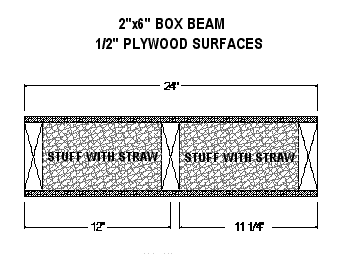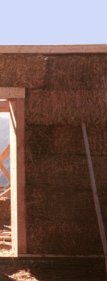Article #5
This is the fifth article in this series about building strawbale homes.
Wall raising continued -
We emphasised the importance of pinning bales and making sure the bales are stacked straight in the last article. This is really important at this stage - it will make your job much easier later on. Wall captains, or someone should be diligent about checking the straightness of your walls. Make sure the corner guides have not moved and the door/window frames have not been pushed out of square. Be patient and check this and fix any problems as the walls go up. We recommend that the owner builder not have any assigned tasks except to oversee this part of the wall construction.
This will payoff (and it's so much easier now) making box beam placement and eventually stuccoing much easier. Don't pin a course of bales until you are satisfied that it is straight and just the way it should be.
Which brings us to box beams, or as described in "Build It With Bales", rigid beam assemblies. No matter what you call them, for load-bearing walls, something has to be on top of the wall for your roof structure to sit on. We have used many of the variations in BIWB and prefer a box beam made of 2x4, 2x6, or TJI (in order of least to most rigid) all combined with plywood tops and bottoms and stuffed with straw. Assemblies are made to various lengths to fit your walls.

*NOTE: This drawing is not meant to be a substitute for your drawings to be submitted to your building official, it is a general drawing to give you an idea of how a box beam is constructed.
Depending on each individual building design, one of these beam assemblies is usually a good choice. Now is a good time to mention structural engineers who will remind us about the length of the span for openings, or the distance between trusses and the roof dead load and the snow load, etc., to determine the appropriate beam assembly. If you have not had any building experience it is a good idea to have your plans reviewed by someone who can calculate or verify that your structure is safe. This does not mean you need to spend thousands of dollars hiring architects and structural engineers. (Although they are highly trained professionals that will ensure your building is safe.)
During our last workshop, one of the volunteers told us about a very reasonably priced engineer familiar with strawbale buildings that he highly recommended. Contact us if you want to hire an engineer and we'll pass along his information.
Here's an example of a wall during construction showing many of the things discussed here and in previous articles. So take a look. This is a load bearing wall with a load bearing door frame. The door frame will support all the weight of any bales and the roof loads above it. This type door frame does not require a separate lintel (as long as you have calculated the wood needed to support across the distance of the door opening.)
Also note the temporary support to keep the wall straight. Here the "box beam" is in place but not connected down to the foundation yet. The hole between the bales just above the door to the right will be stuffed with straw after the wall is secured.
This is a 6 bale high wall using 3 string bales. The resulting ceiling height is about 8'-6". Also note the sill plates under the bales, two 2x4's to give a 3" step up for the bales to sit on. It is inexpensive insurance against future water damage from flooded floors.


This photo shows the green poly strapping on the far wall. This runs under the sill plate (anchor bolted to the footing) and up over the top of the box beams on top of the walls. You can also see the radiant infloor heating tubes (red) and the rough plumbing. All this ready for the concrete floor to be poured. We used rigid 2" insulation under the entire floor.
The next article we'll show you some trusses and talk about getting the roof on your walls as quickly as possible to protect your straw. Post and beam construction gets your roof built before the walls, so protecting your straw is not as much of an issue. If you are planning to build where it is rainy all the time you might want to consider post and beam. We have always built in climates that have some time of year that you can count on it being sunny and dry to build.
If you are interested in building, see our consulting page to see how we can help you. You can e-mail Michael Thomas, Co-Founder of IronStraw Group at: